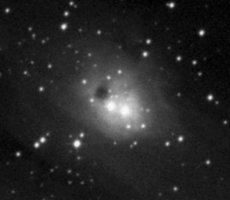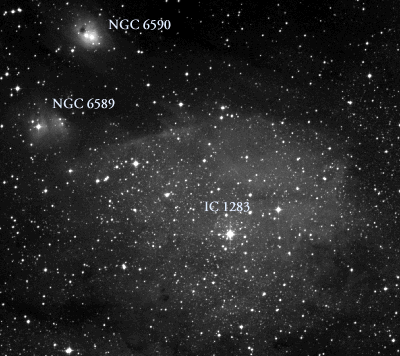| Reflection
Nebula
aka NGC 6595, IC 4700, LBN 43; often confused with NGC 6589, IC 1283, IC 1284 Integrated Visual Magnitude: 11? Apparent Diameter: 4' Mean Surface Brightness: 21-22 mag/arc-sec2 Minimum requirements to detect: 6-inch scope under dark skies |
 I
happened across this very interesting region while previewing DSS images
of open clusters in Sagittarius. I was looking for any clusters that
might have nebulosity associated with them. The DSS image of
the open cluster NGC 6595 held a surprise. No cluster was evident
on the image, but a pair of 11th magnitude stars appeared enveloped in
a relatively bright nebula. Most intriguing, the nebula showed a
small, very distinct, dark cloud superimposed upon it. I immediately
became interested in the prospect of detecting this dark cloud visually.
I
happened across this very interesting region while previewing DSS images
of open clusters in Sagittarius. I was looking for any clusters that
might have nebulosity associated with them. The DSS image of
the open cluster NGC 6595 held a surprise. No cluster was evident
on the image, but a pair of 11th magnitude stars appeared enveloped in
a relatively bright nebula. Most intriguing, the nebula showed a
small, very distinct, dark cloud superimposed upon it. I immediately
became interested in the prospect of detecting this dark cloud visually.
I star hopped to the region with my 18-inch f/4.5, using the DSS image to find the field. Again, no open cluster was apparent, but a pair of fuzzy-looking stars jumped out at me at 94x. A better view was had at 260x, where the nebulosity became much more readily visible.
The nebula should be glimpsed in telescopes perhaps as small as 6-8 inches under dark skies. Make sure to use at least 130x. It will appear at first as a very slight haze surrounding the pair of stars (TYC 6273-1057 and TYC 6273-0884). The coordinates and designations for this object are often confused or in error from the majority of sources, so it is best to use the coordinates of one of these stars to find it. With time and effort you should be able to make out a 4'-long hazy egg about these stars.

The field in an 6-inch f/8
at 50x. North is down and east is to the right.
The dark nebula (or globule) may prove to be a more illusive target. Neither the OIII nor the H-Beta filters had much effect, so I returned for a much longer look without the filter. The dark spot on the image wasn't immediately obvious, but I kept trying using averted vision. When I had my eye at just the right spot the nebula appeared much larger, perhaps by a factor of two. I had some trouble holding this view, but the round dark spot soon became apparent! It appeared just to the southwest of the pair at 260x.
 There
is enormous confusion concerning this object and its neighbors that persists
to this day. The online database SIMBAD, for instance, identifies
the nebula Sh 2-37 at the location of NGC 6590. The existence of
the open cluster which brought me here in the first place, NGC 6595, is
quite questionable. It is the apparent result of a mistake logged
long ago. I was unable to find any recent (on-line) research publications
regarding this object and have come to the conclusion that it is a misclassification
of one of the other objects in this region.
There
is enormous confusion concerning this object and its neighbors that persists
to this day. The online database SIMBAD, for instance, identifies
the nebula Sh 2-37 at the location of NGC 6590. The existence of
the open cluster which brought me here in the first place, NGC 6595, is
quite questionable. It is the apparent result of a mistake logged
long ago. I was unable to find any recent (on-line) research publications
regarding this object and have come to the conclusion that it is a misclassification
of one of the other objects in this region.
To the northwest lies another nebula about a double star. The stars in this pair are much less similar. The confusion in the region has no doubt been aided by the coincidence of two nebulae surrounding a pair of stars . As best as I can tell this is NGC 6589, another reflection nebula. Although not as bright as NGC 6590, it can be observed in telescopes as small as 12-inches, if not smaller. Look for two separate areas of nebulosity near a bright star (10th mag HD 167638).
A bit further away, to the northeast, lies a much larger patch of nebulosity. This is an HII region with some reflection nebula mixed in (in photographs it appears red, with blue streaks and highlights). As best as I can determine this is IC 1283, often confused with IC 1284, which probably does not exist. It is apparently coincident with Gum 78 and RCW 153. I claim this is also the correct identification of Sh 2-37.
This region is about 18' in diameter and is said to be glimpsed with averted vision, although I did not look for it myself. It might make a good target for an OIII or UHC filter (certainly better than the two refection nebulae, which do not respond to these filters).
The image above is taken from the second generation DSS (red). North is down and east is to the right. The field is approximately 25'.
For an analysis of the designation confusion in this region see the article from Canberra Astronomical Society at the bottom of this page.
The
Astronomy Picture of the Day, August 10 1997
Canberra
Astronomical Society - Southern Cross - October 1998
| Millennium
Star Atlas Vol III Chart 1368
Sky Atlas 2000 Chart 22 Uranometria 2000 Vol II Chart 339 |